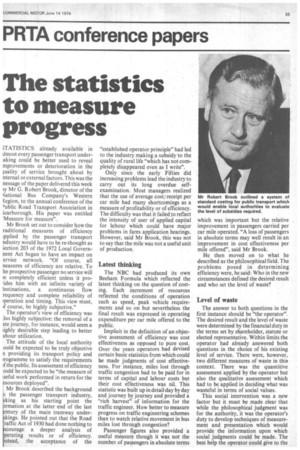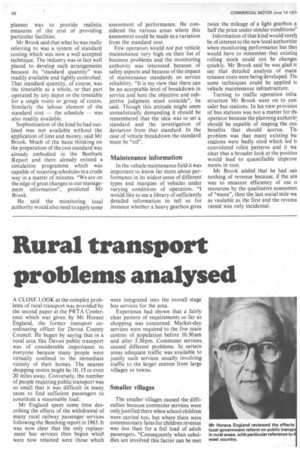The statistics to measure progress
Page 57

Page 58

If you've noticed an error in this article please click here to report it so we can fix it.
iTATISTICS already available in ilmost every passenger transport underaking could be better used to reveal mprovements or deterioration in the itiality of service brought about by nternal or external factors. This was the nessage of the paper delivered this week )3, Mr G. Robert Brook, director of the +rational Bus Company's Western Zegion, to the annual conference of the 3ublic Road Transport Association in icarborough. His paper was entitled 'Measure for measure".
Mr Brook set out to consider how the raditional measures of efficiency Ipplied by the passenger transport ndustry would have to be re-thought as ;ection 203 of the 1972 Local Governnent Act began to have an impact on ervice network. "Of course, all neasures of efficiency are relative. To he prospective passenger no service will )e completely efficient unless it pro'ides him with an infinite variety of lestinations, a continuous flow requency and complete reliability of Teration and timing. This view must, if course, be highly subjective." The operator's view of efficiency was Iso highly subjective: the removal of a ate journey, for instance, would seem a iighly desirable step leading to better abour utilization.
The attitude of the local authority ould be expected to be truly objective n providing its transport policy and irogramme to satisfy the requirements if the public. Its assessment of efficiency ould be expected to be "the measure of iseful work performed in return for the esources deployed".
Mr Brook described the background the passenger transport industry, king as his starting point the rmation at the latter end of the last ntury of the main tramway underkings. He pointed out that the Road raffic Act of 1930 had done nothing to courage a deeper analysis of perating results or of efficiency. stead, the acceptance of the "established operator principle" had led to the industry making a subsidy to the quality of rural life "which has not completely disappeared even as I write".
Only since the early Fifties did increasing problems lead the industry to carry out its long overdue selfexamination. Most managers realized that the use of average cost/ receipt per car mile had many shortcomings as a measure of profitability or of efficiency. The difficulty was that it failed to reflect the intensity of user of applied capital for labour which could have major problems in fares application hearings. However, said Mr Brook, this was not to say that the mile was not a useful unit of production.
Latest thinking
The NBC had produced its own Beeham Formula which reflected the latest thinking on the question of costing. Each increment of resources reflected the conditions of operation such as speed, peak vehicle requirements and so on but nevertheless the final result was expressed in operating expenditure per car mile offered to the public.
Implicit in the definition of an objective assessment of efficiency was cost effectiveness as opposed to pure cost. Over the years operators had devised certain basic statistics from which could he made judgments of cost effectiveness. For instance, miles lost through traffic congestion had to be paid for in terms of capital and labour costs but their cost effectiveness was nil. This statistic was built up in detail day by day and journey by journey and provided a "rich harvest" of information for the traffic engineer. How better to measure progress on traffic engineering schemes than to watch relative movement in bus miles lost through congestion?
Passenger figures also provided a useful measure though it was not the number of passengers in absolute terms which was important but the relative improvement in passengers carried per car mile operated. "A loss of passengers in absolute terms may well result in an improvement in cost effectiveness per mile offered", said Mr Brook.
He then moved on to what he described as the philosophical field. The problems posed in determining efficiency were, he said: Who in the new circumstances defined the desired result and who set the level of waste?
Level of waste
The answer to both questions in the first instance should be "the operator". The desired result and the level of waste were determined by the financial duty in the terms set by shareholder, statute or elected representative. Within limits the operator had already answered both questions in the choice of his existing level of service. There were, however, two different measures of waste in this context. There was the quantitive assessment applied by the operator but also the qualitative assessment which had to be applied in deciding what was wasteful in terms of social values.
This social intervention was a new factor but it must be made clear that while the philosophical judgment was for the authority, it was the operator's duty to develop techniques of measurement and presentation which would provide the information upon which social judgments could be made. The best help the operator could give to the planner was to provide realistic measures of the cost of providing particular facilities.
Mr Brook said that what he was really referring to was a system of standard costing which was now a well accepted technique. The industry was in fact well placed to develop such arrangements because its "standard quantity" was readily available and tightly controlled. That standard quantity, of course, was the timetable as a whole, or that part operated by any depot or the timetable for a single route or group of routes. Similarly the labour element of the standard cost — the schedule — was also readily available.
Sophistication of the kind he had outlined was not available without the application of time and money, said Mr Brook. Much of the basic thinking on the preparation of the cost standard was already embodied in the Beetham Report and there already existed a simulation programme which was capable of recasting schedules in a crude way in a matter of minutes. "We are on the edge of great changes in our management information", predicted Mr Brook.
He said the monitoring local authority would also need to apply some assessment of performance. He considered the various areas where this assessment could be made as a variation from the standard cost.
Few operators would not put vehicle maintenance very high on their list of business problems and the monitoring authority was interested because of safety aspects and because of the impact of maintenance standards on service reliability. "It is my view that there can be no acceptable level of breakdown in service and here the objective and subjective judgment must coincide", he said. Though this attitude might seem unrealistically demanding it should be remembered that the idea was to set a standard and the investigation of deviation from that standard. In the case of vehicle breakdown the standard must be "nil".
Maintenance information
In the vehicle maintenance field it was important to know far more about performance in its widest sense of different types and marques of vehicles under varying conditions of operation. "I would like to see a library of sufficiently detailed information to tell us for instance whether a heavy gearbox gives twice the mileage of a light gearbox a half the price under similar conditions" Information of that kind would sure') be of interest to the new local authoritie; when monitoring performance but the would have to remember that existini rolling stock could not be changet quickly. Mr Brook said he was glad tt say that detailed analysis of main tenance costs were being developed. Tit( same techniques could be applied tt vehicle maintenance infrastructure.
Turning to traffic operation infra structure Mr Brook went on to con sider bus stations. In his view provisiol of bus stations was not a matter for tb operator because the planning authorit: should be capable of reaping the cos benefits that should accrue. Tb problem was that many existing bu stations were badly sited which led t( convoluted robte patterns and it wa clear that a broader look at the positioi would lead to quantifiable improve ments in cost.
Mr Brook added that he had sal( nothing of revenue because, if the amn was to measure efficiency of use o resources by the qualitative assessmen of "waste", then the last social mile wa as vaulable as the first and the reventt raised was only incidental.




























































































































